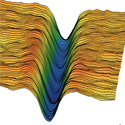A clean slate
Scanning tunneling spectroscopy (STS) has played a pivotal role in the investigation of the normal and superconducting states of the cuprate high-temperature superconductors because it can probe electronic properties, such as the superconducting energy gap, with atomic resolution.
Since STS is a surface-sensitive probe, the success of the method depends crucially on the quality of the crystal surface. Cleaved crystals should expose a single, atomically smooth plane, ideally without any surface reconstruction. In a Rapid Communication appearing in Physical Review B, Takuya Kato and collaborators from the Universities of Tokyo and Tsukuba in Japan carry out an STS investigation of , which is structurally the simplest of the newly discovered iron-based high-temperature superconductors. They observe an atomically resolved square crystal lattice with no surface reconstruction; in contrast, other iron-based superconductors such as and have complicated surface structures that depend on how they were prepared. Kato et al. also measure a spatially homogeneous superconducting gap in , in sharp contrast to the gap inhomogeneity present in cuprate superconductors, adding to the list of differences between these two classes of materials.
Given that it has such a simple structure and a high-quality surface that lends itself to STM measurements, may prove to be the model system for a significant breakthrough in understanding iron-based superconductivity. – Alex Klironomos





